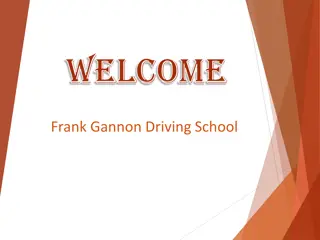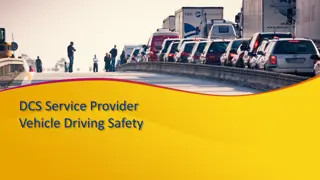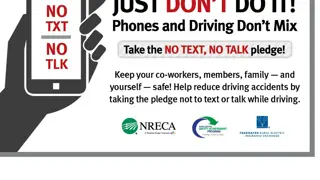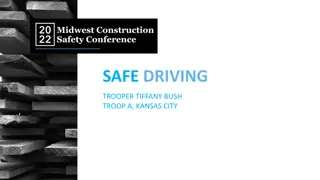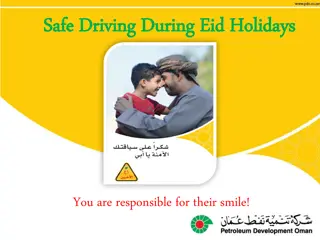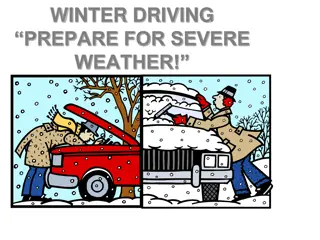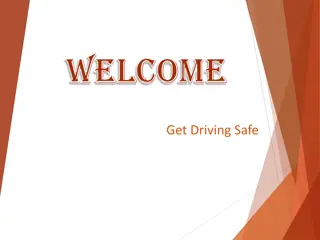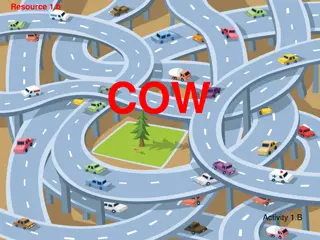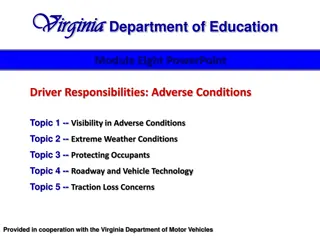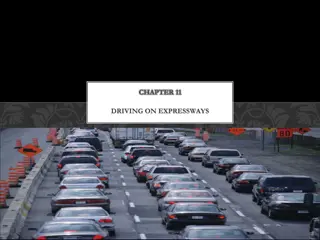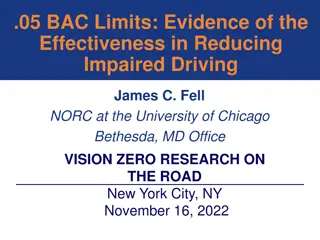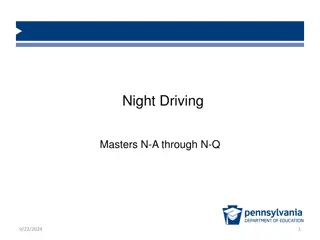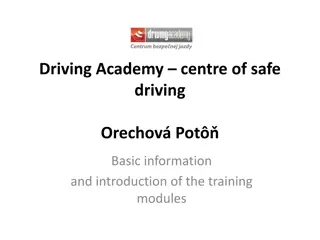Important Safe Driving Rules and Regulations
Understanding the safe driving rules and regulations is crucial for all motorists. Speed limits vary depending on the location, with fines doubling for exceeding certain limits. It's essential to slow down in specific situations like narrow roads, intersections, or wet conditions. The Safe Corridors law imposes increased fines for various driving offenses on state highways. Knowing when passing is permitted based on center line markings and which side to pass on is key. Remember to keep right unless passing, and yield to emergency vehicles and other special road users.
Download Presentation

Please find below an Image/Link to download the presentation.
The content on the website is provided AS IS for your information and personal use only. It may not be sold, licensed, or shared on other websites without obtaining consent from the author.If you encounter any issues during the download, it is possible that the publisher has removed the file from their server.
You are allowed to download the files provided on this website for personal or commercial use, subject to the condition that they are used lawfully. All files are the property of their respective owners.
The content on the website is provided AS IS for your information and personal use only. It may not be sold, licensed, or shared on other websites without obtaining consent from the author.
E N D
Presentation Transcript
25 MPH = School zones, business or residential districts 35 MPH = Suburban business and residential districts 50 MPH = Non-posted rural roadways 55 MPH = Certain state highways and interstates 65 MPH = Certain interstate highways Motorist pay double fines for exceeding the 65 MPH limit by 10 MPH or more.
Always slow down: On narrow or winding roads At intersections or railroad crossings On hills At sharp or blind curves Where there are pedestrians or driving hazards When the road is wet or slippery A motorist should judge their speed control by existing conditions
The Safe Corridors law doubles fines on various state highways for a variety of driving offenses, including speeding and aggressive driving.
Both Center Lines are solid: NO Passing Allowed One Center line is broken: Passing is allowed only on the side with the broken line Both Center lines are broken: Passing is allowed on both sides
Most passing should be on the left. Passing on the right is allowed only on roads with more than one lane going in the same direction. If vehicles on the roadway are moving in two or more continous lines or when the motorist ahead is making a left turn and there is room to pass.
The laws of NJ require motorist to keep to the right, except when passing.
Emergency Vehicles: Police cars, fire trucks, and ambulances are giving warning signs. Buses: When re-entering the flow of traffic Postal vehicles: When vehicle is seeking to re- enter the flow of traffic Motorized or mobility assistance devices: when in a crosswalk or seeking to cross the road
A motorist must : Stop for a pedestrian in crosswalks, failure to stop carries a fine of up to $500, up to 25 days in jail, community service, driving privilege suspension of up to 6 months and 2 points.
At a multi-way stop or stop intersection, a motorist must yield to the motorist on the right if both motorist get there at the same time. A motorist should also yield to another motorist already stopped at the intersection. When making a left turn at an intersection, a motorist must yield to oncoming traffic and to stop for pedestrians within the crosswalk. Driving on Private Property to avoid a traffic signal or sign is a motor vehicle violation.
An intersection is uncontrolled when two or more roads join and there is no traffic signal or regulatory device. As a motorist nears a crossroad that is not controlled, they must reduce speed and be ready to stop.
Motorist enter these roadways by way of acceleration lanes, which are extra lanes at the highway entrances used by motorist to speed up to join the flow of traffic.
Exit ramps or deceleration lanes, which are extra lanes at a highway exit, are located on the right hand side of the roadway. If a motorist misses an exit ramp on a highway, they should go to the next exit.
Adjust steering and speed when approaching a curve Best way to enter a curve is to slow down before entering and avoid drifting into another lane.
Unless a NO Turn on Red Sign is posted, NJ law allows a right turn on a red light after a motorist comes to a complete stop and checks for traffic.
When a yellow light follows a green light, a motorist but stop before entering the intersection, unless yellow appears when the vehicle is too close to stop safely.
A motorist must stop at least 15 feet from railroad crossings when there are flashing lights, ringing bells or flag signals.
Motorist must stop for a school with flashing red lights. Must stop at least 25 feet away, if they re traveling on a 2-lane road or on a multi-lane highway where lanes are only separated by lines on a privately maintained road. Motorist should slow to 10 MPH if on the other side of a safety island or raised median.
NJ law requires all motorist to yield to emergency vehicles when they sound sirens, or flashing red or blue emergency lights. A motorist should steer to the extreme right of the roadway.
Headlights must be used: Half Hour after sunset Half Hour before sunrise Headlights must also be used when visibility is 500 feet or less, when using windshield wipers, fog, mist, smoke, or other factors that reduce visibility.
Do NOT Park: Within 10 feet of a fire hydrant Within 25 feet of a crosswalk Within 50 feet of a stop sign
NJ Law prohibits the use of handheld electronic devices while driving a vehicle on any public road or highway. Handheld cellular device may be used only in certain emergency situations which includes: Fire Traffic Accident Serious Road Hazard Medical Emergency Hazardous material emergency
Throwing trash, debris or rubbish from a moving or parked vehicle is ILLEGAL





